Problems with public paths
Andrew loves walking and shares with us his experiences of how our paths could be improved.

I live in Cardiff with my fiancée Bex and our rescue dog Lily. It’s a vibrant and thriving city with a rich cultural history. However, what really sets Cardiff apart for me is its accessibility to the coastline and countryside. When we have the chance, we can easily jump in the car and quickly be in the Brecon Beacons or one of South Wales’s beaches.
I’ve always had a deep enjoyment for exploring the outdoors and walking continues to play a significant role in my daily routine. One of the primary benefits I get from walking is the support for my mental wellbeing. I see it as a natural stress reliever. Whenever I feel overwhelmed, or stressed, a walk outdoors in nature allows me to clear my head.
Although we live in a city, we’re quite fortunate that there’s quite a lot of greenery around us. From our front door, we can see our nearest park at the end of the street and we’re only a 10- or 15-minute walk from a few other city parks including Bute Park, one of the largest parks in Cardiff.

Walking in urban areas
Some of the streets in Cardiff are lined with trees on either side of the road. This looks beautiful but their roots grow out of the pavement and over time they have pushed up the pavement slabs. This can make it difficult to walk along the pavements, particularly in the rain and for those who use mobility aids.
Built-up urban areas within the city can also be quite overwhelming with the noise from the traffic, construction and having a lot of people all concentrated in a one area. I’m Neurodiverse and this can often lead to sensory overload, which can sometimes negate the benefits of walking for me.
Walking in the countryside
One of the significant hurdles we’ve faced when walking in the countryside is the inconsistencies in how some farmers maintain paths that go through their land. For example, we’ve encountered some walks where stiles and signage have been completely removed or gates have been locked. This can cause walkers to become lost, forcing them to find alternative routes, and deviate from the intended path. Sometimes you feel that you are forced onto private land and/or into difficult environments to navigate.
Stiles
Most paths have an array of different stiles along the route, and some can cause difficulties when walking the dog if they don’t have a gate or dog flap. Our dog Lily is a medium sized dog and hates being picked up. So, when we’re in situations where there’s a stile that can only be stepped over, we either need to redirect our walk or push our way through a nearby hedge.
Poorly maintained paths
Overgrown and poorly maintained paths are another obstacle for walkers. Just recently we went for a nice walk to Ruperra Castle in Newport, South Wales after work. However, one section of the path was completely overgrown with hedges, including nettles up to shoulder height. We had to fight our way through to stay on the public footpath as diverting from the path would have added a lot of extra time onto our walk, which we didn’t have due to it getting dark.
I also believe that some public footpaths have become outdated over time. Last year, Bex and I took Lilly our dog on what was supposedly a circular walking route. However, our enthusiasm was dampened when halfway through the walk, the designated public footpath unexpectedly led us onto a grass path alongside a busy road. In places we had to step out into the road to avoid overgrown hedges. I imagine it was a safe route when the path was originally established but with the current levels of traffic on the road, it’s unfortunately rendered the walk unsafe. It’s a shame, because it was quite a nice walk until that point but it would be really dangerous with young children and dogs in tow. I reported it to the council but never received a response back.

Researching walking routes
I use Google Maps to research places where we can go and walk, whether we’re at home or away somewhere. I’ll usually read reviews and check out the images of places that come up to help us decide where we want to go. It’s great for that but I wish that Google Maps also showed public footpaths. If we are not familiar with the area, finding a public footpath can often be a gamble. However, to properly plan out our walks, I typically need to search for information about the public footpaths in the area online, usually through a council website. It would be brilliant to see councils collaborating with companies like Google.

Problems on public paths
We’re committed to removing barriers to help everyone get out walking. Learn how to deal with any problems you encounter on your walk.

Towpath walks: the answer to one walker’s failing eyesight
Despite failing eyesight, Peter, a member of the Ramblers, is enjoying long-distance canal-side towpath walks with his son.

Passing on the love of walking through the generations
Daniel’s grandparents inspired in him a love of walking which he is in turn passing on to his young daughter.